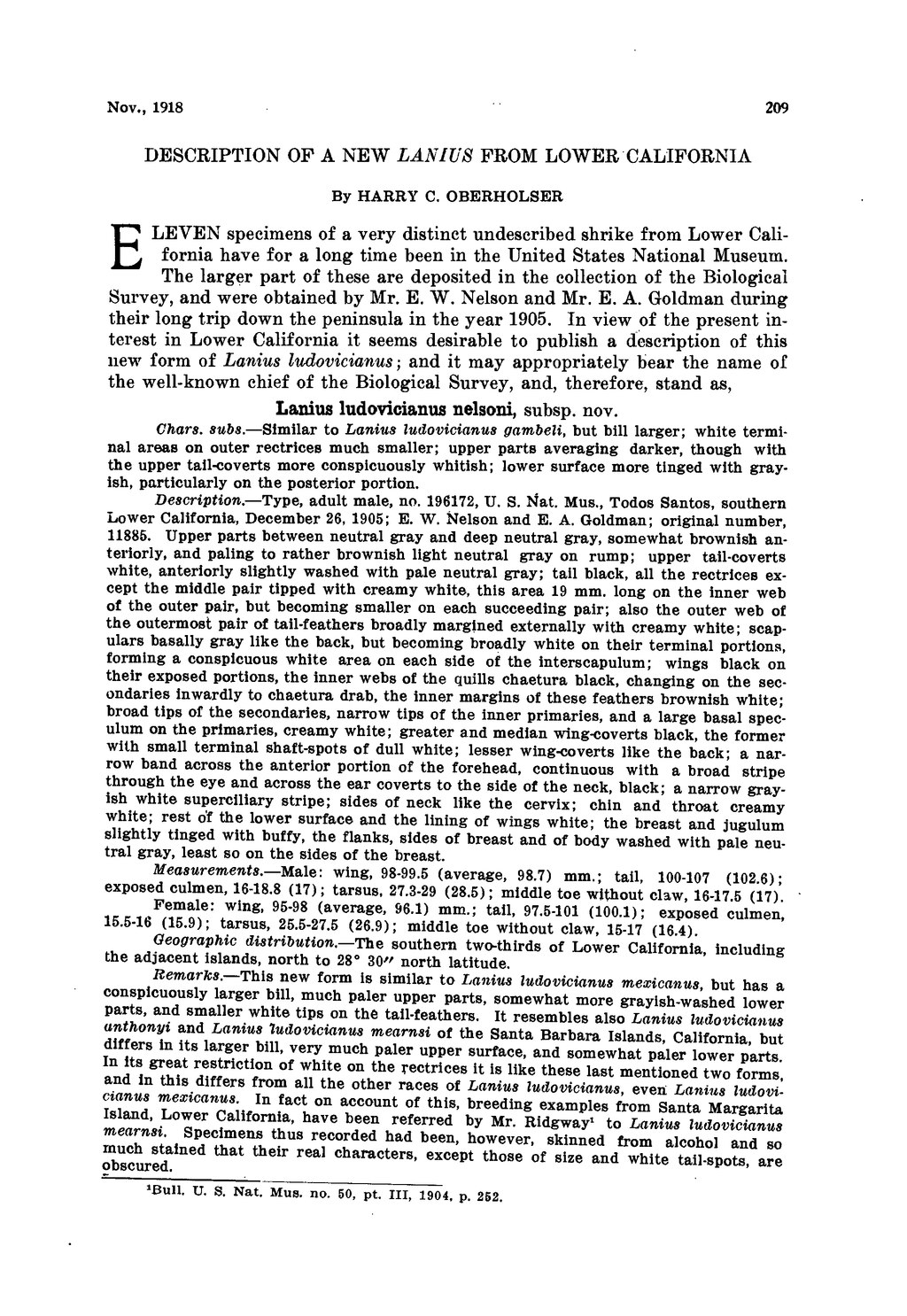Nov., 1918 " 209 DESCRIPTION OF A NEW LANIUS FI?OM LOWEl?'CALIFOl?NIA By HARRY C. OBERHOLSER LEVEN specimens of a very distinct undescribed shrike from Lower Cali- fornia have for a long time been in the United States National Museum. The larger part of these are deposited in the collection of the Biological Survey, and were obtained by Mr. E. W. Nelson and Mr. E. A. Goldman during their long trip down the peninsula in the year 1905. In view of the present in- terest in Lower California it seems desirable to publish a description of this new form of Lanius l?dovicianus; and it may appropriately bear the name of the well-known chief of the Biological Survey, and, therefore, stand as, Lanius ludovicianus nelsoni, subsp. nov. Chars. subs.--Similar to Lanius ludovicianus gainbell, but bill larger; white termi- nal areas on outer rectrices much smaller; upper parts averaging darker, though with the upper taft-coverts more conspicuously whitish; lower surface more tinged with gray- ish, particularly on the posterior portion. Description.--Type, adult male, no. 196172, U.S. l?at. Mus., Todos Santos, southern Lower California, December 26, 1905; E. W. Nelson and E. A. Goldman; original number, 11885. Upper parts between neutral gray and deep neutral gray, somewhat brownish an- teriorly, and paling to rather brownish light neutral gray on rump; upper tail-coverts white, anteriorly slightly washed with pale neutral gray; tail black, all the rectrices ex- cept the middle pair tipped with creamy white, this area 19 min. long on the inner web of the outer pair, but becoming smaller on each succeeding pair; also the outer web of the outermost pair of tail-feathers broadly margined externally with creamy white; scap- ulars basally gray like the back, but becoming broadly white on their terminal portions, forming a conspicuous white area on each side of the interscapulum; wings black on their exposed portions, the inner webs of the quills chaetura black, changing on the sec- ondaries inwardly to chaetura drab, the inner margins of these feathers brownish white; broad tips of the secondaries, narrow tips of the inner primaries, and a large basal spec- ulum on the primaries, creamy white; greater and median wing-coverts black, the former with small terminal shaft-spots of dull white; lesser wing-coverts like the back; a nar- row band across the anterior portion of the forehead, continuous with a broad stripe through the eye and across the ear coverts to the side of the neck, black; a narrow gray- ish white superciliary stripe; sides of neck like the cervix; chin and throat creamy white; rest o'f the lower surface and the lining of wings white; the breast and jugulum slightly tinged with buffy, the flanks, sides of breast and of body washed with pale neu- tral gray, least so on the sides of the breast. Measurements.--Male: wing, 98-99.5 (average, 98.7) min.; tail, 100-107 (102.6); exposed culmen, 16-18.8 (17); tarsus, 27.3-29 (28.5); middle toe ?vithout cl?w, 16-17.5 (17). Female: wing, 95-98 (average, 96.1) min.; tail, 97.5-101 (100.1); exposed culmen, 15.5-16 (15.9); tarsus, 25.5-27.5 (26.9); middle toe without claw, 15-17 (16.4). Geographic distribution.--The southern two-thirds of Lower California, including the adjacent islands, north to 28 30? north latitude. Remarks.--This new form is similar to Lanius ludovicianus mexicanus, but has a conspicuously larger bill, much paler upper parts, somewhat more grayish-washed lower parts, and smaller white tips on the tall-feathers. It resembles also Lanius ludovicianus anthonyi and Lanius 7udovicianus mearnsi of the Santa Barbara Islands, California, but differs in its larger bill, very much paler upper surface, and somewhat paler lower parts. In its great restriction of white on the rectrices it is like these last mentioned two forms, and in this differs from all the other races of Lanius ludovicianus, evea Lanius ludovi- cianus mexicanus. In fact on account of this, breeding examples from Santa Margarita Island, Lower California, have been referred by Mr. Ridgway ? to Lanius ludovicianus mearnsi. Specimens thus recorded had been, however, skinned from alcohol and so much stained that their real characters, except those of size and white tail-spots, are obscured. ?BulL U.S. Nat. Mus. no. 50, pt. III, 1904, p. 252.
Page:Condor20(6).djvu/15
This page needs to be proofread.
